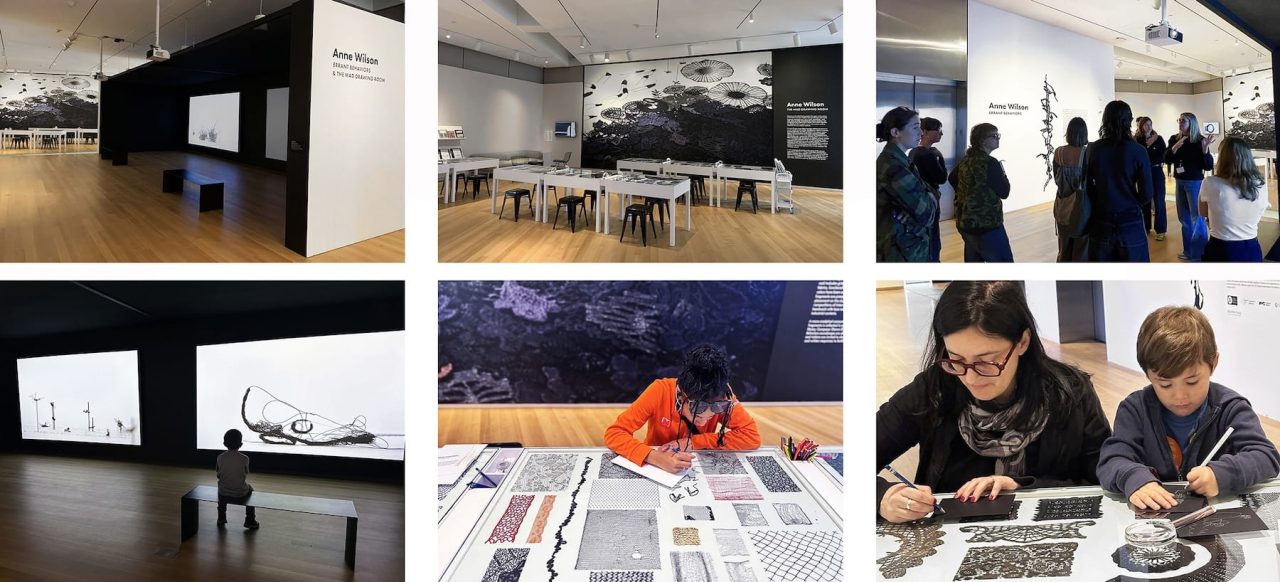
Anne Wilson: The MAD Drawing Room and Errant Behaviors
Museum of Arts and Design, New York City (April 20, 2024 – May 11, 2025)
Curator: Elissa Auther, Deputy Director of Curatorial Affairs and the William and Mildred Lasdon Chief Curator,
Museum of Arts and Design
Errant Behaviors is a 2-screen video and sound installation which proposes surreal implications and intersections between textile, moving image, and sound. In the adjacent gallery, the MAD Drawing Room is composed of 8 study tables of Wilson’s lace and openwork fragments, source materials from which the Errant Behaviors animations were created. Composer Shawn Decker’s sound sources, used to create environments of sonic activity which mirror the behaviors in the animations, are presented across 3 wall monitors. The MAD Drawing Room also includes a library for reading and research, and an opportunity for visitors to slow down to look closely and listen, and to respond through drawing and writing.
Wilson started collecting found lace fragments as a material source to make Topologies, an artwork first shown in the 2002 Whitney Biennial and represented by a large wall mural in the MAD Drawing Room. She worked from these same lace sources as subjects to animate in the creation of Errant Behaviors.
Wilson searches for damaged lace bits, parts or fragments of larger wholes – sometimes passed down from family or gifts from friends, but most often acquired from flea markets and church rummage sales. If the lace wasn’t already a dark color, it was dyed – privileging the graphic aspect of linear structures against a lighter surface.
The MAD Drawing Room includes fragments of traditional laces alongside a selection of other kinds of openwork – including grids, sheers, and meshes from commercial fabrics, functional nets and gauzes – all presented as study samples in the manner of an archive. The hand dyeing of fragments opens to a broader color range using natural dyestuffs. The rationale for placement on the study tables is visual and subjective, creating compositions of interrelationships that combine Wilson’s own handwork with lace and openwork from diverse origins.
Extending from Wilson’s Davis Street Drawing Room (2022-23), the participatory aspect of the MAD Drawing Room invites visitors to pick up a pencil, paper, and hand magnifier and to sit at a study table to look closely and draw or write. Or, to read in the library or photograph. Prompts are available for both slow close looking and listening. Visitor responses are welcome, if visitors choose to share their responses on a designated wall space. In the lineage of art practices that foreground the relationship between artist and audience, these participant responses shape the collective meaning-making of this experience.
The MAD Drawing Room is about slow close looking and listening, about invention and critical thinking, about finding complexity and meaning in textiles and sound, and about the everyday and contemporary art.

Acknowledgements
Many thanks to individuals who shared their photographs of the exhibition: Diana Guerrero-Maciá, G. Jesse Sadia, Janet Purdy, Jen Chen-su Huang, Jenni Sorkin, Katarina Weslien, Liene Bosquê, Lillian Stafford, Martha Poggioli, Nneka Kai, Théo Bignon, and others. Special thanks to photographer Steve Pitkin (Pitkin Studio) who formatted the wall mural.
Thanks to those who posted drawings on the MAD Drawing Room wall. All drawings will eventually become part of the museum’s exhibition archive.
Thanks to artist and Wilson’s former studio assistant, Sofía Fernández Díaz, for all her contributions to the MAD Drawing Room, including her expert skills in natural dyeing. Thanks to the many individuals who donated lace and openwork to Wilson for use in this project. And much gratitude to Chicago-based lacemaker, Kathy Kauffmann, for consulting on the identification of the traditional laces in the MAD Drawing Room, available in the Identification binder in the Drawing Room library.
A special thanks to the Curator of this exhibition, Elissa Auther (Deputy Director of Curatorial Affairs and the William and Mildred Lasdon Chief Curator), who worked closely with Wilson to realize all aspects of the exhibition. Many thanks also to Elizabeth Koehn (Assistant Curator) and Lillian Stafford (Curatorial Affairs Assistant and Assistant Registrar), along with the amazing design and installation team including Sasha Nixon, Willow Holdorf, and Thuto Durkac-Somo. Much appreciation to artist Susan Peterson for support and workshop assistance. And finally, thanks to Wilson’s collaborator, artist and composer Shawn Decker, whose sound makes Errant Behaviors come alive!